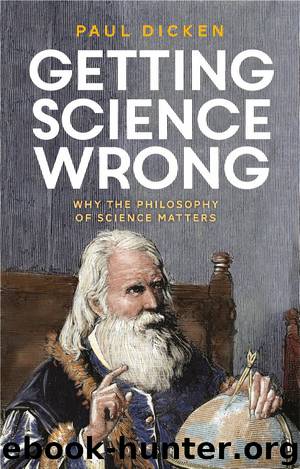Getting Science Wrong by Paul Dicken

Author:Paul Dicken [Dicken, Paul]
Language: eng
Format: epub
Tags: Why the philosophy of science matters
Publisher: Bloomsbury Publishing Plc
Published: 2018-01-15T00:00:00+00:00
In search of the aether
It might be helpful before we proceed to look a little closer at some of the key ideas behind Einstein’s theory of relativity, and in particular, just why it managed to elicit the sort of conceptual horror that it did amongst individuals like Paul Weyland. In the nineteenth century, the Scottish physicist James Clerk Maxwell demonstrated that light was a special type of wave—part of the electromagnetic spectrum that runs from x-rays and microwaves at one end, through the various colors of the visible spectrum, and up to ultraviolet radiation at the other—and went on to determine its velocity and other important properties. One issue that remained somewhat unresolved, however, was the medium through which waves of light were supposed to be transmitted. In the case of a sound wave, for instance, we know that it can be transmitted through a body of water or the air around us through (roughly speaking) the successive collision of individual molecules. But there does not appear to be any such physical medium in the case of light, which travels from distant stars through the reaches of outer space where any such molecules are in very short supply.
Maxwell proposed therefore that there must be another, as yet undiscovered medium facilitating the propagation of light. This was called the luminiferous aether and was supposed to permeate every single nook and cranny of the universe in order to accommodate the almost ubiquitous waves of light that surround us. It was precisely because the aether was so pervasive that explained why up to that moment no one had noticed its existence, in much the same way that one imagines that a fish is completely unaware of the water through which it swims. Nevertheless it stood to reason that if the aether did exist, then there must be some way of measuring it. In particular, since the Earth is constantly rotating on its axis in its orbit around the Sun, it would seem to follow that it must in fact be in constant motion with respect to this all-pervasive aether, which should in turn entail any number of experimental consequences. In 1888, two American physicists named Albert Michelson and Edward Morley set out to perform just such an experiment.
The underlying idea was relatively simple. While Maxwell had established that the velocity of a wave will be determined by the properties of the medium through which it is traveling—which is why for example sound travels faster in air than it does in a more densely packed medium like water—our judgment of the relative velocity of a wave will also depend upon our own motion through that medium. If we happen to be moving through the medium towards the source of the wave for instance, we will judge the wave to be moving with a greater velocity, whereas if we are moving through the medium away from the source of the wave we will judge it to be moving with a lesser velocity. In the case
Download
This site does not store any files on its server. We only index and link to content provided by other sites. Please contact the content providers to delete copyright contents if any and email us, we'll remove relevant links or contents immediately.
Enlightenment Now: The Case for Reason, Science, Humanism, and Progress by Steven Pinker(6405)
The Immortal Life of Henrietta Lacks by Rebecca Skloot(3826)
A Journey Through Charms and Defence Against the Dark Arts (Harry Potter: A Journey Through…) by Pottermore Publishing(3604)
Elon Musk by Ashlee Vance(3455)
Origin Story: A Big History of Everything by David Christian(3139)
A Journey Through Divination and Astronomy by Publishing Pottermore(3070)
COSMOS by Carl Sagan(2950)
Enlightenment Now by Steven Pinker(2917)
Alchemy and Alchemists by C. J. S. Thompson(2911)
Inferior by Angela Saini(2831)
Bad Pharma by Ben Goldacre(2730)
Shadow of Night by Deborah Harkness(2718)
A Mind For Numbers: How to Excel at Math and Science (Even If You Flunked Algebra) by Barbara Oakley(2691)
Origin Story by David Christian(2683)
Signature in the Cell: DNA and the Evidence for Intelligent Design by Stephen C. Meyer(2501)
A Brief History of Time by Stephen Hawking(2473)
A Journey Through Potions and Herbology (A Journey Through…) by Pottermore Publishing(2434)
The Elements by Theodore Gray(2432)
The End of Faith by Sam Harris(2290)
